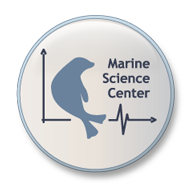Detection of DMS
Dimethyl sulphide (DMS) is an odorant that is released when zooplankton is grazing on phytoplankton. The ability to perceive DMS would guide a harbour seal directly to these places of high productivity where it would then find its prey. In this experiment we determined the detection threshold for DMS in harbour seals. Our seals were indeed able to detect very low concentrations of DMS and thus could use it for finding foraging grounds (Kowalewsky et al. 2006). It now needs to be determined in a final open field experiment if e. g. wild harbour seals are attracted to areas with high DMS concentrations.
Detection of salinity gradients
In the marine habitat salinity variations occur as vertical stratifications or river plumes. If harbour seals were able to detect these salinity gradients they could use them for orientation. In this experiments our harbour seals were shown to be highly sensitive for salinity differences that occur in their natural habitat (Sticken et al. 2000). Thus they possess the basis for gustatory orientation in the marine habitat.


